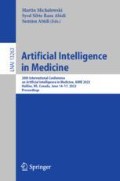Abstract
With mHealth apps, data can be recorded in real life, which makes them useful, for example, as an accompanying tool in treatments. However, such datasets, especially those based on apps with usage on a voluntary basis, are often affected by fluctuating engagement and by high user dropout rates. This makes it difficult to exploit the data using machine learning techniques and raises the question of whether users have stopped using the app. In this paper, we present a method to identify phases with varying dropout rates in a dataset and predict for each. We also present an approach to predict what period of inactivity can be expected for a user in the current state. We use change point detection to identify the phases, show how to deal with uneven misaligned time series and predict the user’s phase using time series classification. We evaluated our method on the data of an mHealth app for tinnitus, and show that our approach is appropriate for the study of adherence in datasets with uneven, unaligned time series of different lengths and with missing values.
Access this chapter
Tax calculation will be finalised at checkout
Purchases are for personal use only
References
Bagnall, A., Lines, J., Bostrom, A., Large, J., Keogh, E.: The great time series classification bake off: a review and experimental evaluation of recent algorithmic advances. Data Min. Knowl. Discov. 31(3), 606–660 (2016). https://doi.org/10.1007/s10618-016-0483-9
Cederroth, C.R., et al.: Towards an understanding of tinnitus heterogeneity. Front. Aging Neurosci. 11, 53 (2019)
Chen, T., Guestrin, C.: XGBoost: a scalable tree boosting system. In: Proceedings of the 22nd ACM SIGKDD International Conference on Knowledge Discovery and Data Mining, KDD 2016, pp. 785–794. ACM (2016)
Cismondi, F., Fialho, A.S., Vieira, S.M., Reti, S.R., Sousa, J.M., Finkelstein, S.N.: Missing data in medical databases: impute, delete or classify? Artif. Intell. Med. 58(1), 63–72 (2013)
Eysenbach, G.: The law of attrition. J. Med. Internet Res. 7(1), e402 (2005)
Fryzlewicz, P.: Unbalanced Haar technique for nonparametric function estimation. J. Am. Stat. Assoc. 102(480), 1318–1327 (2007)
Hochheimer, C.J., Sabo, R.T., Krist, A.H., Day, T., Cyrus, J., Woolf, S.H.: Methods for evaluating respondent attrition in web-based surveys. J. Med. Internet Res. 18(11), e301 (2016)
Hochheimer, C.J., Sabo, R.T., Perera, R.A., Mukhopadhyay, N., Krist, A.H.: Identifying attrition phases in survey data: applicability and assessment study. J. Med. Internet Res. 21(8), e12811 (2019)
Jenks, G.F.: The data model concept in statistical mapping. Int. Yearb. Cartogr. 7, 186–190 (1967)
Keogh, E.J., Chu, S., Hart, D., Pazzani, M.J.: An online algorithm for segmenting time series. In: Proceedings of the 2001 IEEE International Conference on Data Mining, pp. 289–296 (2001)
Killick, R., Fearnhead, P., Eckley, I.A.: Optimal detection of changepoints with a linear computational cost. J. Am. Stat. Assoc. 107(500), 1590–1598 (2012)
Schlee, W., et al.: Measuring the moment-to-moment variability of tinnitus: the TrackYourTinnitus smart phone app. Front. Aging Neurosci. 8, 294 (2016)
Schleicher, M., et al.: Understanding adherence to the recording of ecological momentary assessments in the example of tinnitus monitoring. Sci. Rep. 10(1), 1–13 (2020)
Williams-Kerver, G.A., et al.: Baseline and momentary predictors of ecological momentary assessment adherence in a sample of adults with binge-eating disorder. Eat. Behav. 41, 101509 (2021)
World Health Organization and Others: Adherence to long-term therapies: evidence for action. World Health Organization (2003)
Acknowledgements
This project has received funding from the European Union’s Horizon 2020 Research and Innovation Programme under grant agreement number 848261. Thanks go to Vishnu Unnikrishnan for his control reading.
Author information
Authors and Affiliations
Corresponding author
Editor information
Editors and Affiliations
Appendix
Appendix
Rights and permissions
Copyright information
© 2022 The Author(s), under exclusive license to Springer Nature Switzerland AG
About this paper
Cite this paper
Schleicher, M., Pryss, R., Schlee, W., Spiliopoulou, M. (2022). When Can I Expect the mHealth User to Return? Prediction Meets Time Series with Gaps. In: Michalowski, M., Abidi, S.S.R., Abidi, S. (eds) Artificial Intelligence in Medicine. AIME 2022. Lecture Notes in Computer Science(), vol 13263. Springer, Cham. https://doi.org/10.1007/978-3-031-09342-5_30
Download citation
DOI: https://doi.org/10.1007/978-3-031-09342-5_30
Published:
Publisher Name: Springer, Cham
Print ISBN: 978-3-031-09341-8
Online ISBN: 978-3-031-09342-5
eBook Packages: Computer ScienceComputer Science (R0)


